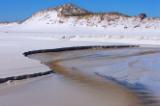 © Steve Vaughn/Panoramic Images (Florida Title Image Large)
© Steve Vaughn/Panoramic Images (Florida Title Image Large)

Natural Geography of Florida
Florida is home to 45 terrestrial ecosystems that range from small islands of subtropical hammocks and rocklands to vast dry prairies, sandhills, scrubs, flatwoods and floodplain forests. And despite having little change in elevation, the difference of a few feet on the Florida peninsula can yield major landscape variations. Within flatwoods, for example, nearly imperceptible drops in elevation create a mosaic of depression marshes, dome swamps, and wet prairies. The topography changes more dramatically in the Panhandle where high bluffs and steep ravine systems flank the Apalachicola River and its tributaries.
The state’s 1,200 miles of coastline, including estuaries, seagrass beds, mangrove swamps, and coral reefs, together with thousands of inland freshwater lakes, rivers, streams and springs, support numerous aquatic communities. Florida’s current and historic coastlines also influence its geology. Rising and receding seas deposited great quantities of limestone over many thousands of years, resulting in an abundance of karst features such as sinkholes, caves, depressions, limestone outcrops and more than 300 large artesian springs. A series of sand ridges in the central peninsula were once islands surrounded by a vast sea, isolating plants and animals that evolved into unique species. The state’s peninsular geography spans temperate and subtropical zones, which, combined with its distinctive geology and climate, contribute to habitat diversity as well as an amazing array of species.
Florida’s geography can be divided into natural categories such as watersheds, corridors and ecoregions that can help in conservation planning and priority setting.
Naturally Defined Geography of Florida
-
Watersheds of Florida
Watersheds function as both a physiographic reality and an important organizing concept for conservation.
-
Corridors in Florida
By providing largely uninterrupted links between high-quality habitats, conservation corridors provide important benefits to migratory species and help ensure the long-term health of ecosystems and species, especially in the face of threats such as climate change.
-
Ecoregions in Florida
Ecoregions are determined by patterns of vegetation, physiography, geology, soils, hydrology and climate. Using ecoregions as a framework for assessing the distribution and status of species and ecosystems makes biological sense, compared to using politically derived lines like county, state or national boundaries.









